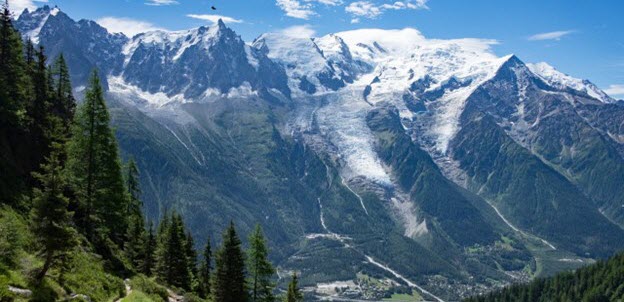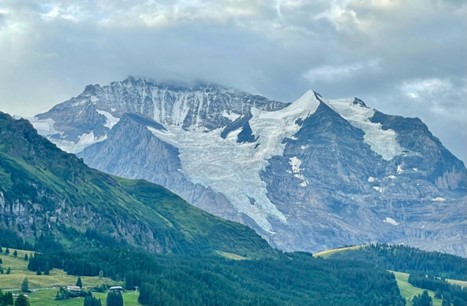| By Amy Hackney Blackwell |
All over the Alps, people are walking on glaciers. Or in them.
For the price of a cable car ticket (which is expensive because this is Switzerland and glaciers are high up), a tourist can zoom to the top of a mountain with a bird’s-eye view of a glacier directly below. At the summit, they play in the snow―even in August. In Chamonix, Grindelwald, Gstaad, and Engelberg, tourists visit ice caves cut into glaciers and do icy cliff walks above the glaciers. Those who ride the Jungfraujoch, Europe’s highest railroad, can dine on fondue while looking out over the Large Aletsch Glacier, the largest glacier in Switzerland. Summer tourists in Zermatt can even go skiing on a glacier.
All the big, famous Alps have glaciers slithering down their slopes―the Eiger, the Jungfrau, the Mönch, the Matterhorn. Mont Blanc is covered in them.
The Swiss tourism industry has been selling the beauty and drama of glaciers since the 1700s. Visitors to Mont Blanc in Chamonix, France, once hired guides to carry them up the slopes on mules to get a close view of the jagged surface of the Mer de Glace. They bridged crevasses with wooden ladders.
Cog railroads and funiculars made the mountains more accessible in the 1900s, and still run today. A vast network of ski lifts along with a comprehensive bus and train system now make it possible for nearly anyone to get close to glaciers.
Glaciers in the Alps aren’t walled off. Anyone can walk up to a glacier and touch it. Hikers can reach the edges of glaciers on Switzerland’s extremely well marked trails, like the trail around the Aletsch glacier. They can even climb onto the ice and stroll around.
Which is not necessarily a good idea. Glaciers aren’t gentle landscapes. They’re jagged ice riddled with crevasses, which may or may not be visible. The careless and unlucky have been known to plunge in. Or to be crushed under seracs, ice towers that can suddenly topple over.
The wise course is to hire a guide. Professionals bring tourists on glacier walks every day, supplying their guests with crampons and roping groups together. Even with gear, walking on a glacier isn’t for the clumsy or the acrophobic.
Skiing on glaciers is even more perilous. Winter skiers who attempt the Vallée Blanche in Chamonix are strongly advised to hire a guide and to follow very closely.) It’s a good idea to carry an avalanche beacon. Just in case.
Hot summer is the best time to see the violent damage glaciers do to the ground beneath them. Hanging valleys, terminal moraines, and big hunks of rock known as glacial erratic all show where the land was once covered with masses of slow-moving ice. Superfine glacial sediment today turns mountains, streams, and lakes a distinctive milky blue color.
The glaciers in the Alps are currently melting faster than they re-form. Riding over the Titlis glacier in the revolving cable car gives an excellent view of ice melting in the July sun. Paintings from the 1700s show the Mer de Glace stretching down into the Chamonix Valley. Today its snout is high on the slopes of Mont Blanc. In Zermatt this year, it was too hot for summer skiing. The Swiss Federal Institute for Forest, Snow and Landscape Research reports that, on average, the Alps’ glaciers have lost half their volume since 1931.1
Millions of people visit the Alps every year. The fact that the glaciers are melting is now part of the attraction, as visitors rush to see them before they disappear.
- ETH Zurich, “A Historical Perspective on Glacial Retreat,” Accessed September 21, 2022.

About the Author
Amy Hackney Blackwell’s research areas include plant conservation, historic botany, and the international legal regime governing the ownership of genetic resources. She lives in South Carolina with her family and several cats. In her free time, she enjoys kayaking in Texas, hiking in the Alps, and ballroom dancing.



